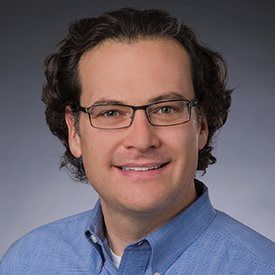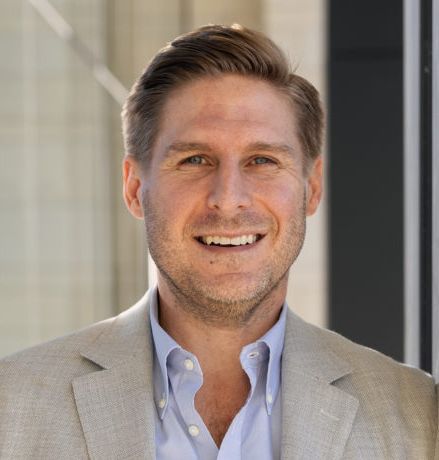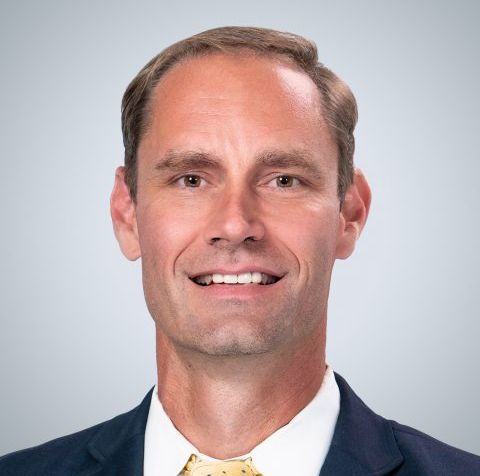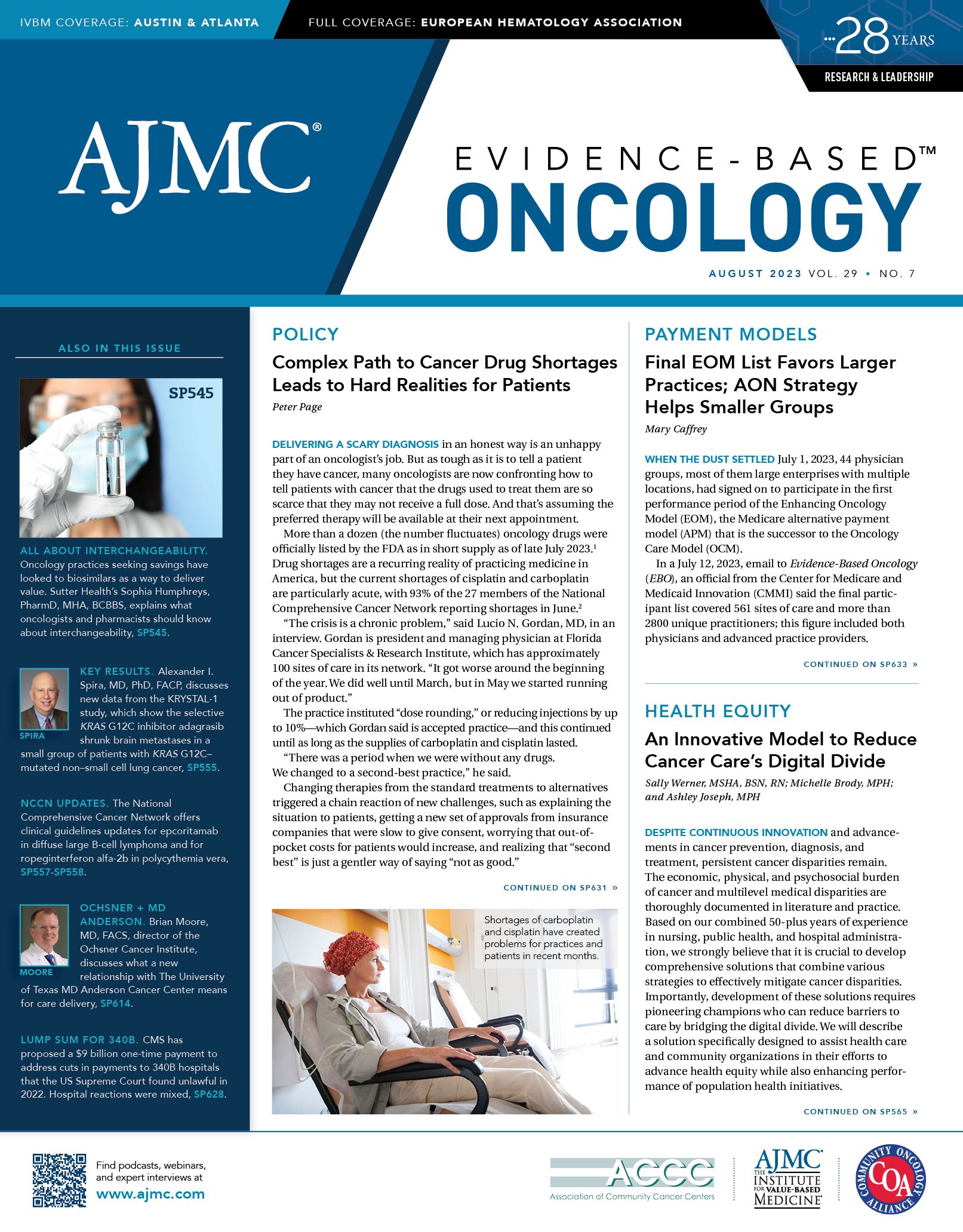Publication
Article
Evidence-Based Oncology
Final EOM List Favors Larger Practices; AON Strategy Helps Smaller Groups
https://doi.org/10.37765/ajmc.2023.89421
When the dust settled July 1, 2023, 44 physician groups, most of them large enterprises with multiple locations, had signed on to participate in the first performance period of the Enhancing Oncology Model (EOM), the Medicare alternative payment model (APM) that is the successor to the Oncology Care Model (OCM).
In a July 12, 2023, email to Evidence-Based Oncology (EBO), an official from the Center for Medicare and Medicaid Innovation (CMMI) said the final participant list covered 561 sites of care and more than 2800 unique practitioners; this figure included both physicians and advanced practice providers.
The participant list now appears on the CMS website.1
Participants include several practices whose leaders were advocates for value-based care during the OCM, such as Texas Oncology, Tennessee Oncology, and Northwest Medical Specialties; other large, well-known practices participating included Rocky Mountain Cancer Centers, Minnesota Oncology, West Cancer and Research Institute, and The Cancer & Hematology Centers of Western Michigan. Of the 44 physician groups enrolled, 30 were participants in the OCM, according to information emailed from the Community Oncology Alliance (COA), which represents independent practices.
But some well-known practices have opted not to participate, including The Center for Cancer and Blood Disorders, which has 16 sites centered in Fort Worth, Texas; and Florida Cancer Specialists & Research Institute, which has 100 sites. Both were successful OCM participants. Also missing are the New Mexico Cancer Center and its CEO, Barbara L. McAneny, MD, whose successful COME HOME project was a precursor to the OCM.2
Practices had until the minute before midnight June 30, 2023, to decide whether to join the EOM. A June 27, 2023, announcement from the CMMI, which operates APMs under the Affordable Care Act, stated that 67 practices would participate, compared with 122 practices that were still in the OCM at the end of June 2022. Although 44 practices would seem an even bigger drop-off than some predicted, it’s not an apples-to-apples comparison, because a group of practices in the American Oncology Network (AON) are enrolled in the EOM under a single tax ID, a feature that practice leaders say has existed since the network’s inception. (Under EOM rules, all practices had the option to aggregate for the purpose of sharing risk.3)
The AON entity, American Oncology Partners, covers 72 sites of care across 23 practices, including several single-site practices, according to information from AON. CMMI now organizes the participant list by site of care, and it has updated its online map to reflect which individual locations are taking part in the EOM. Under the OCM, maps were based on practice headquarters.
Building On the OCM
Elizabeth Fowler, PhD, JD, CMS deputy administrator and director of CMMI, said in a statement emailed to EBO that the EOM, a 5-year voluntary model, builds upon the lessons of the OCM while calling for greater accountability.
Fowler

“One of CMS’ top priorities is to ensure that all Americans have access to equitable, high-quality, and affordable care, including those who are undergoing cancer care. CMS is testing a new model of cancer care that aims to improve clinical outcomes, the patient experience, affordability, and equity for Medicare beneficiaries,” Fowler said in the email. “The Enhancing Oncology Model focuses on people with Medicare undergoing chemotherapy for certain cancer types and is aligned with one of the key goals of President Biden’s Cancer Moonshot initiative by better supporting patients and enhancing their care experience.”
The EOM framework has some similarities to the OCM—it is built around 6-month episodes that are triggered when a patient starts therapy—but it has some key differences, some of which were flash points in talks between oncologists and CMMI, as follows4:
- The EOM only includes patients receiving systemic therapy (not hormonal therapy) for 7 common cancer types: breast cancer, chronic leukemia, small intestine/colorectal cancer, lung cancer, lymphoma, multiple myeloma, and prostate cancer.
- Monthly payments to practices in the EOM will be $70 per patient per month (PMPM), down from $160 PMPM, for required services such as patient navigation; however, practices get another $30 PMPM for those who are dually eligible.
- The EOM calls on practices to collect electronic patient-reported outcomes data and develop plans to address health equity.
“CMS’ goal is to have model participants fully engaged in the model test and willing to move the needle on accountable care and improving access to affordable care,” Fowler said in the email. “CMS is excited to work with the Enhancing Oncology Model participants to help them be successful with the model’s implementation and to partner with payers that have committed to aligning their oncology value-based payment models with the Enhancing Oncology Model.”
Both OCM veterans and practices without payment model experience noted that the EOM required them to take on more work with less revenue to support the required services and that its risk models offer very little room for error. In addition, EOM had no test period to learn how it works, as was done with the OCM. In interviews with leaders of oncology networks, this facet and the risk models themselves posed particular challenges for smaller practices. Both were cited in a May 2023 survey by COA, in which 71% of practices said they would not take part in the EOM.5
Considerations for Practices
The largest number of EOM physicians are affiliated with The US Oncology Network (The Network), which has 12 practices in the payment model,
Wilfong

including Texas Oncology, which has 530 physicians.6 In an interview, Lalan Wilfong, MD, senior vice president for payer and care transformation for The US Oncology Network, discussed the major areas of consideration for practices.
Practice readiness. Each practice went through a process to evaluate its ability to assess patients’ health-related social needs (a new requirement), its handling of therapy utilization, and staffing needs under the model.
Market considerations. “Some of our markets are moving very quickly to value-based care, where the vast majority of all their payers are moving to value-based care. In that scenario, adding on EOM just was another program that used a lot of the same tools they were using anyway,” Wilfong said. “And in some markets, not a single payer outside of Medicare has anything to do with value-based care.”
In the latter scenario, conversations would center on whether the EOM would be the launching pad to prepare for upcoming market shifts, which some practices did years earlier with the OCM. Practices leaders would need to envision their area market in 3 to 5 years. Would the EOM help the practice get ahead of the game?
Analytics and projections. The Network looked at each practice’s financial performance and other factors to project whether saving could be achieved. Practices that had undergone transformation for the OCM were generally seen as likely to perform well in the EOM. For some smaller practices, facets of the EOM risk model could make savings a challenge, depending on the case mix. As Wilfong explained, a small practice could swing from a 30% likelihood of savings to a 30% likelihood of having to repay money depending on which types of cancer it treated in a 6-month period. Regional variation in the EOM was a factor, too, because some areas are very expensive—which makes it easier to succeed, because there are savings to find.
A Challenging Final Week
Multiple sources have told EBO that that the week leading up to July 1 was stressful. A few practices saw their names appear on a preliminary June 27 EOM participant list while they were still making final evaluations. One practice confirmed it appeared on website while it was in the process of telling CMMI it would not participate. Practices only had a few weeks to review their data from CMMI and rush to obtain reinsurance agreements.
Schleicher

Stephen M. Schleicher, MD, MBA, chief medical officer at Tennessee Oncology, said his practice’s final decision was less an endorsement of EOM specifics than a broader, long-term commitment to value-based care—and a desire to keep a seat at the table if CMMI is willing to adjust the model over its 5-year life.
“The first time I could say 100% that we were doing it was probably 2 days before July 1,” Schleicher said. “And then it kind of came down to we would rather be in the model and 6 months later decide we don’t want to do it vs never [having] the chance to participate.”
He continued, “We didn’t make a 5-year decision; we said, ‘We’re committed to value-based care, we don’t want to not do it.’ ”
If the model works out well, Schleicher said, Tennessee Oncology would not have a way to join EOM after July 1. Others also cited this issue, as well as the fact that the EOM will be operating alongside the new Oncology Medical Home, a venture from COA and the American Society of Clinical Oncology.
AON Strategy Helps Single Sites, Smaller Groups
The AON care sites are listed under “American Oncology Partners, PA,” an entity first created in 2017.7 An AON spokesperson stated in an email that the group is considered a separate EOM physician group participant under a single tax ID number, and that AON has operated as a practice under this mechanism since the beginning; this was not a response to the EOM. Overall, AON supports 26 practices and 79 sites of care.
Compared with the very large practices elsewhere in the EOM, the AON practices taking part in the EOM have fewer sites of care—Genesis Cancer and Blood Institute in Arkansas, home to AON’s chief medical officer, Stephen “Fred” Divers, MD, is relatively large with 11 sites. Asked if the network’s strategy helps smaller groups manage CMMI’s risk model, AON leaders responded:
“As EOM is a 2-sided risk model smaller practices may not have the ability to support the infrastructure to implement and support enhanced patient services and the analytics infrastructure to assess performance. Most oncology groups in the US still have less than 5 physicians. The AON model provides the support, diversification, and the infrastructure to not only allow these groups to survive but rather thrive and participate in novel payer programs, such as EOM.”
In separate announcement that coincided with the start of the EOM, 2 longtime leaders from Oncology Consultants in Houston, Texas, accepted leadership roles with AON. Alti Rahman, MHA, MBA, the longtime practice administrator at Oncology Consultants, was named AON’s chief strategy and innovation officer. Susan Sabo-Wagner, MSN, RN, OCN, NEA-BC, who had been Oncology Consultants’ executive director of clinical strategy, is now AON’s vice president of clinical innovation.8
Shortly after the July 1 launch, AON announced a partnership with Thyme Care to provide comprehensive cancer care support and navigation services for AON patients. According to the statement, AON will use Thyme Care’s data-driven solutions as an extension of AON practices, offering patients “a dedicated team of nurse practitioners, oncology nurses, and on-demand resource specialists who can help them navigate the clinical, emotional, psychological, and social barriers to care.”9
Divers

“Oncology is facing an inflection point as the industry moves toward value-based care. AON is proud to be participating in the EOM,” Divers said in an AON news release. “We look forward to realizing the goals of EOM as a network and leading the charge toward value-based cancer care.”9
Bobby Green, MD, cofounder, president, and chief medical officer of Thyme Care, added, “We’re thrilled to partner with AON’s organization of community oncologists who are at the heart of delivering cancer care and therapies in their communities. It’s an honor to work alongside them to ensure all cancer patients have access to the support and resources they deserve. Together with AON, we can accelerate EOM to achieve a better patient experience, better outcomes and lower costs of cancer care.”9
A Small Practice Bows Out
Wilfong said besides the challenges of case mix, small practices don’t enjoy the same economies of scale when hiring navigators or other staff needed to meet EOM requirements; these employees consume a larger share of the budget for a practice with 10 doctors vs one with several dozen.
This is an issue that Kashyap Patel, MD, cited when explaining why his practice, Carolina Blood and Cancer Care Associates, opted against the EOM. Patel, a former COA president who was an OCM cheerleader and operated that model successfully, said he fully supported CMMI’s effort to include a health equity component in the EOM, something that was missing from the earlier payment model. But in April 2023, he wrote a commentary for EBO stating that the model’s financial incentives were not sufficient to achieve its health equity goals.10 (Patel is the associate editor for EBO.)
In a June 2023 interview, Patel said there were several reasons why his practice did not proceed with the EOM, starting with the lack of resources to fully address health equity as called for in the model. Second, Patel said, the significant decline in Monthly Enhanced Oncology Services (MEOS) revenue, resulting from both the smaller PMPM payment and much smaller pool of eligible patients, would create an ethical challenge for a small practice such as his. Under the OCM, the MEOS revenue was sufficient to hire enough staff to provide services for all patients, not just those in the model. Under EOM, Patel said, that would not be possible.
“I personally feel it is not appropriate to distinguish between 2 [patients with cancer],” he said.
Third, Patel said, CMS has not responded to his inquiries about addressing long COVID-19 as a comorbidity that affects cancer onset and progression. And finally, he said, the model does not incorporate the most state-of-the-art biomarkers needed for guideline concordant precision medicine.
Looking ahead, Patel sees opportunities to work with regional payers near his practice to retain the best elements of value-based care. He said he willing to work with both commercial payers and with CMS “to build a pilot that can include a disparities initiative.”
However, he said, small practices in particular need resources to do this correctly. “Identifying problems without having resources to address them does not make sense from my perspective,” Patel said.
From the moment the EOM was unveiled in June 2022, Schleicher warned that its structure would create “selection bias,” with larger practices experienced in value-based care opting in and smaller practices opting out. He coauthored an article suggesting changes to entice small practices into the model, but CMMI did not make the changes.11 “Hopefully, we all have more opportunity to discuss this throughout this process,” he said.
Wilfong said CMMI has been willing to listen but that changes could be difficult. “Big changes to the model are challenging for them, just from a regulatory standpoint,” he said. “They made themselves available to meet regularly to answer questions and give feedback.”
References
1. Enhancing Oncology Model. CMS website. Updated July 12, 2023. Accessed August 6, 2023. https://innovation.cms.gov/innovation-models/enhancing-oncology-model
2. Oncology Medical Home. New Mexico Cancer Center. Accessed August 7, 2023. https://nmcancercenter.org/come-home/
3. Enhancing Oncology Model fact sheet. CMS. June 27, 2022. Accessed August 6, 2023. https://www.cms.gov/newsroom/fact-sheets/enhancing-oncology-model
4. Caffrey M. Amid concerns, will practices take part in the Enhancing Oncology Model? Am J Manag Care. 2023;29(4):SP328.
5. Caffrey M. Most community oncology practices give thumbs down to Enhancing Oncology Model, survey finds. The American Journal of Managed Care. June 6, 2023. Accessed August 6, 2023. https://bit.ly/3OnP9Ov
6. Wilfong L, Staggs S. 12 practices in The Network participating in the EOM. The US Oncology Network. Accessed August 6, 2023. https://usoncology.com/news/12-practices-in-the-network-participating-in-eom/
7. American Oncology Partners P.A. provides pathology, labs to enhance patient services. News release. April 4, 2019. Accessed August 6, 2023. https://bit.ly/3OObsi4
8. American Oncology Network names Alti Rahman new chief strategy and innovation officer. News release. AON. July 18, 2023. Accessed August 6, 2023. https://bit.ly/3YrdlEz
9. American Oncology Network announces participation in the Enhancing Oncology Model. News release. AON. July 26, 2023. Accessed August 6, 2023. https://bit.ly/47pd2OD
10. Patel K. EOM payments are not sufficient to achieve health equity goals. Am J Manag Care. 2023;29(4):SP330.
11. Mullangi S, Parikh RB, Schleicher SM. Next-generation alternative payment models in oncology—will precision preclude participation? JAMA Oncol. 2023;9(4):457-458. doi:10.1001/jamaoncol.2022.7179






